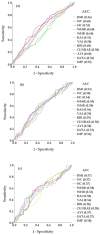Relationship of Different Anthropometric Indices with Vascular Ageing in an Adult Population without Cardiovascular Disease-EVA Study
- PMID: 35566797
- PMCID: PMC9105296
- DOI: 10.3390/jcm11092671
Relationship of Different Anthropometric Indices with Vascular Ageing in an Adult Population without Cardiovascular Disease-EVA Study
Abstract
The objectives of this study were to analyse the capacity of different anthropometric indices to predict vascular ageing and this association in Spanish adult population without cardiovascular disease. A total of 501 individuals without cardiovascular disease residing in the capital of Salamanca (Spain) were selected (mean age: 55.9 years, 50.3% women), through stratified random sampling by age and sex. Starting from anthropometric measurements such as weight, height, and waist circumference, hip circumference, or biochemical parameters, we could estimate different indices that reflected general obesity, abdominal obesity, and body fat distribution. Arterial stiffness was evaluated by measuring carotid-femoral pulse wave velocity (cf-PWV) using a SphygmoCor® device. Vascular ageing was defined in three steps: Step 1: the participants with vascular injury were classified as early vascular ageing (EVA); Step 2: classification of the participants using the 10 and 90 percentiles of cf-PWV in the study population by age and sex in EVA, healthy vascular ageing (HVA) and normal vascular ageing (NVA); Step 3: re-classification of participants with arterial hypertension or type 2 diabetes mellitus included in HVA as NVA. The total prevalence of HVA and EVA was 8.4% and 21.4%, respectively. All the analysed anthropometric indices, except waist/hip ratio (WHpR), were associated with vascular ageing. Thus, as the values of the different anthropometric indices increase, the probability of being classified with NVA and as EVA increases. The capacity of the anthropometric indices to identify people with HVA showed values of area under the curve (AUC) ≥ 0.60. The capacity to identify people with EVA, in total, showed values of AUC between 0.55 and 0.60. In conclusion, as the values of the anthropometric indices increased, the probability that the subjects presented EVA increased. However, the relationship of the new anthropometric indices with vascular ageing was not stronger than that of traditional parameters. Therefore, BMI and WC can be considered to be the most useful indices in clinical practice to identify people with vascular ageing in the general population.
Keywords: anthropometric indices; early vascular ageing; healthy vascular ageing; obesity.
Conflict of interest statement
The authors declare that they have no competing interests.
Figures


Similar articles
-
Association of Insulin Resistance with Vascular Ageing in a General Caucasian Population: An EVA Study.J Clin Med. 2021 Dec 8;10(24):5748. doi: 10.3390/jcm10245748. J Clin Med. 2021. PMID: 34945044 Free PMC article.
-
Vascular aging and its relationship with lifestyles and other risk factors in the general Spanish population: Early Vascular Ageing Study.J Hypertens. 2020 Jun;38(6):1110-1122. doi: 10.1097/HJH.0000000000002373. J Hypertens. 2020. PMID: 32371801
-
Gut microbiota and its relationship with early vascular ageing in a Spanish population (MIVAS study).Eur J Clin Invest. 2024 Sep;54(9):e14228. doi: 10.1111/eci.14228. Epub 2024 Apr 24. Eur J Clin Invest. 2024. PMID: 38655910
-
Sex differences in fat distribution influence the association between BMI and arterial stiffness.J Hypertens. 2017 Jun;35(6):1219-1225. doi: 10.1097/HJH.0000000000001297. J Hypertens. 2017. PMID: 28441693
-
Developing technologies to assess vascular ageing: a roadmap from VascAgeNet.Physiol Meas. 2024 Dec 30;45(12):121001. doi: 10.1088/1361-6579/ad548e. Physiol Meas. 2024. PMID: 38838703 Free PMC article. Review.
Cited by
-
Arterial Stiffness Assessment by Pulse Wave Velocity in Patients with Metabolic Syndrome and Its Components: Is It a Useful Tool in Clinical Practice?Int J Environ Res Public Health. 2022 Aug 19;19(16):10368. doi: 10.3390/ijerph191610368. Int J Environ Res Public Health. 2022. PMID: 36012003 Free PMC article. Review.
-
Diabetes Affects the Relationship between Heart Rate Variability and Arterial Stiffness in a Gender-Specific Manner.J Clin Med. 2022 Aug 23;11(17):4937. doi: 10.3390/jcm11174937. J Clin Med. 2022. PMID: 36078867 Free PMC article.
-
Comparing the power of obesity indices to predict cardiovascular diseases at different ages: An application of conditional time-dependent ROC curve in Healthy Heart Cohort of Yazd, Iran.ARYA Atheroscler. 2025;21(1):36-43. doi: 10.48305/arya.2025.42469.2938. ARYA Atheroscler. 2025. PMID: 40401210 Free PMC article.
-
The associations of obesity phenotypes with the risk of hypertension and its transitions among middle-aged and older Chinese adults.Epidemiol Health. 2023;45:e2023043. doi: 10.4178/epih.e2023043. Epub 2023 Apr 10. Epidemiol Health. 2023. PMID: 37054724 Free PMC article.
References
Grants and funding
LinkOut - more resources
Full Text Sources

